Here are two more of the pieces I have in the works, both of which have left me a bit stumped. I started these with no clear intention, and although I advocate letting go of the idea of a
specific outcome, it's not a bad idea to start with a clear beginning. It can be quite fruitful and also fun to begin with no particular set of parameters: let's just make marks and see where they lead. That's where these started, but I'm not finding it very satisfying at this point because I had the idea that they would be Pieces, not just marks. I've found some elements I'd like to work with - the white-on-white texture, the veiled lines, the incised marks, and to some extent the primary colors. OK great. I've discovered, perhaps, some new vocabulary.
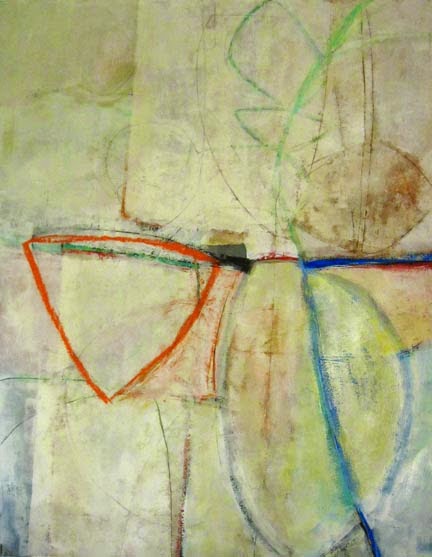 |
| Here is where I left off at the end of May. |
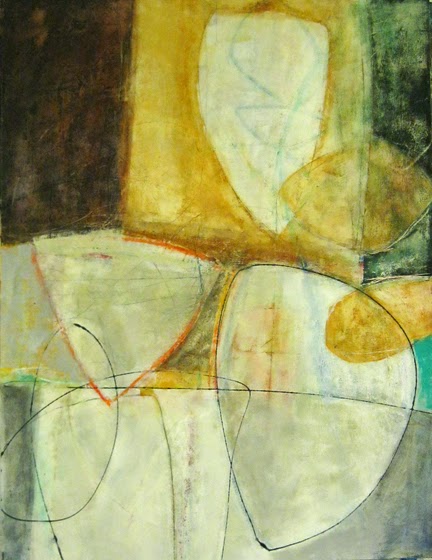 |
| The piece went here... |
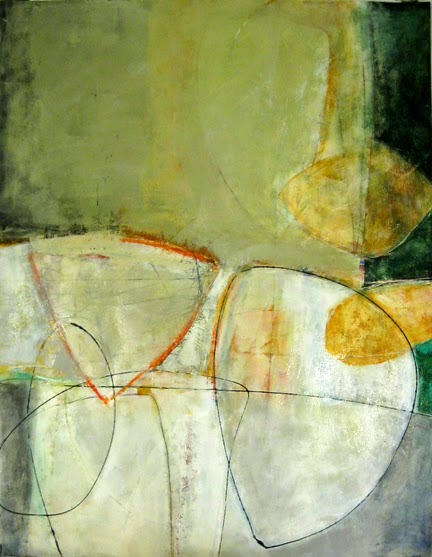 |
| And then here, and it is very much unfinished. |
Another Piece in Process:
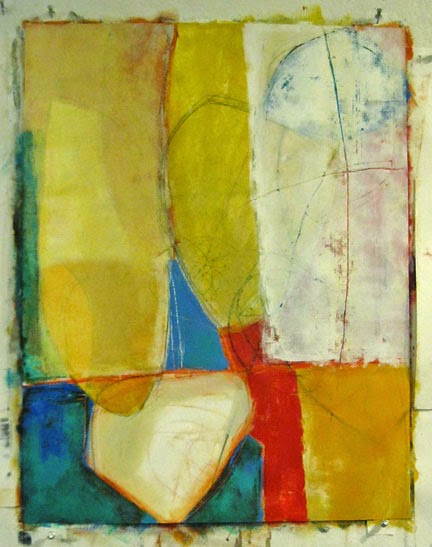 |
| This is several steps/layers into the process. |
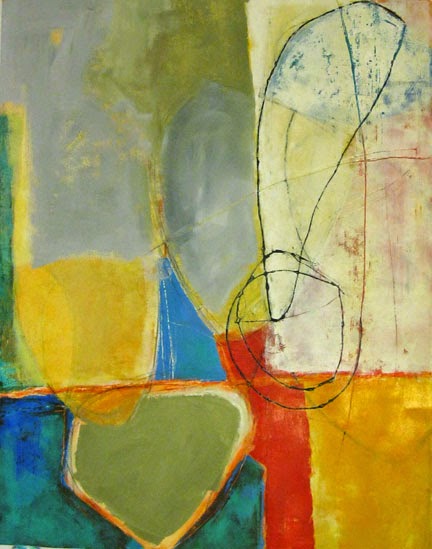 |
| Another couple of layers. I liked the quality of the black lines in the upper right, made with High Flow acrylic in a fine line applicator |
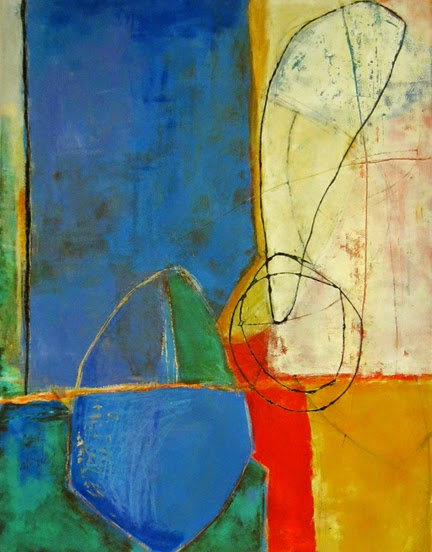 |
| Emphasizing blue |
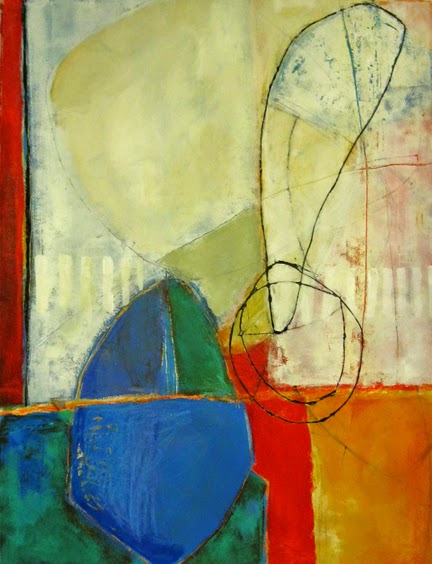 |
| Painting over the blue |
At this point I think I will just take what I've learned from these and begin some fresh pieces. Put them aside, and see if subsequent explorations suggest any further development on these. I browsed
Pinterest and made notes of specific things that resonate, which I might incorporate into these or subsequent pieces. I'll see how that translates in the studio. What To Do Next, I think, is to start another group of pieces and try to be specific about my Starting Points. What issues do I want to explore? What elements do I want to work with? And then let the pieces develop from there.
This business of making art is such a balancing act between intention and spontaneity, between considered decision and intuitive response. This is one of the things that makes art exciting and fresh, but also, at times, frustrating. I will let you know how it goes.
Blind Drawing video up next. Stay tuned. Thanks for visiting!








my 2 cents, is that like another friend of mine, you are messing with them too much - my mantra is "less is better than more" How about some "sparks"of color here and there - like maybe some green or purple in the top or middle of the bottom one. One of my teachers used to have us use pieces of construction paper and mo ve them around before painting to see if we liked it. Another method that I use in watercolor is to use overhead transparencies and paint whatever I'm thinking about on that and move it around before I actually paint it on the painting. I think I learned that from a book by Tom Hill - he used it to see if he wanted a shadow or a tree or something before he actually painted it.
ReplyDeleteYeah, another friend of mine said "you are trying too hard". But If my INTENTION was to just mess with paint, make some marks, let one thing lead to another, then they'd be fine. They would not be "pieces", but I would not have gotten frustrated. Sometimes it really IS fun to just let things wander, as a practice. Anyhow, I appreciate your suggestions. LOVE the colored paper idea!
DeleteA balancing act. How true. I think that you usually manage to balance well so these will come along in time. I am preparing to try my first representational painting in quite a while. It will take some balancing also although of a slightly different variety.
ReplyDeleteThe older woman looking at her younger self? Is that the painting you are preparing for? I've been wondering if at some point I will start doing representational paintings. Maybe of my chickens.
DeleteLOVE your blog!! Who set the world onto fast forward? I'm WITH You! Put on the brakes, for chrissake!
I would never presume to offer advice. I know you'll find the path to perfection. I AM curious about how you achieve the translucency with the light colors over the dark. Scraping? AGL? I love the look.
ReplyDeleteLights over darks. Hmmm. Hard to describe. Lots of layering. Any chance you can come to a workshop? There are a bunch of techniques I use to achieve that, and I love the look too. Thanks.
DeleteHow I would love to be in a workshop, but they are never in my area. Any hope of a video class?
DeleteI do online classes. The one called "Extreme Composition" has some techniques like this.
DeleteHow funny. I'm always so busy reading about what you've done/are doing that I never noticed the "online class" tab. I'm going to have to check this out. Thanks!
DeleteThank you for honestly sharing your thoughts, your process, your progress -- or lack of same. It so open, so unpretentious. I love the richness and the texture of the white/cream, and the black line. Sometimes you make things seem so logical, so purposeful in your videos. It is special to also see the struggle, the frustration -- and the new vocabulary? May be not entirely art related. ;-)
ReplyDeleteInspiration and helpfull.. I am riffing off these ideas.. thanks
ReplyDeleteThere are some prices that take you and then there are other pieces that never reach that ah-ha point. I've even burned one that was driving me crazy!
ReplyDeleteHi Wen! I doubt if I will burn these. I will cherish them, in fact, and use them for further exploration. I will THANK them for giving me a little clarity on Starting Points. Wen, you should meet BJ, whose comment is above. BJ, meet Wen.
Deletei really like reading about your process; for several reasons: it is refreshing to know how long it can take an artist to work through a piece; it is encouraging to see that all artists, even well-known ones like you, rethink and alter plans as a piece progresses; it is nice to see your thought process evolve and how different the finished piece can be from its original inspiration. art is one of the few journeys that allows its travelers the privilege of bird walking (side journeys). these are important discoveries and i appreciate you sharing them.
ReplyDeleteSome of my paintings that I love the most are ones I've been close to throwing in the bin at some point. They've often been in a state where I really like them. Then I do some more and feel I've ruined them. Then I'm close to chucking them out. Sometimes I brutally "destroy" them in frustration then work on them again months later. Sometimes I just leave them until I feel inspired again. Often I use them as a place to clean my paint brushes as I hate wasting paint. And then somewhere along the time I end up with something I love even more than the painting I had before I "ruined" it. What a magical process! The more I let go of outcome and play the more unexpected happy accidents I create. The only paintings I've ever actually chucked in the bin are ones I've physically damaged and even then I've cut out bits of them to use on other pieces. Oops. Got a bit carried away there! :-) Thanks for sharing your process Jane. I love reading your posts and am inspired by your art!
ReplyDeleteI am a big fan of the way you work, use color and design. I work in encaustic on glass and set the unfinished work in the window of my studio to ponder. I often turn the piece 90 degrees and re- evaluate. Some of my best pieces come from rework. I believe this is true because there is an essential spark or element in the first effort. Releasing it though requires thought sometimes with wonderful results and often not easy.
ReplyDelete